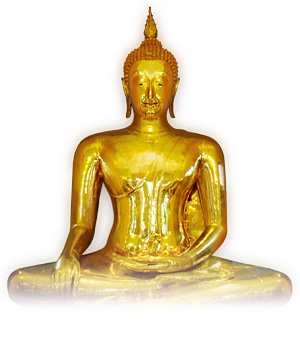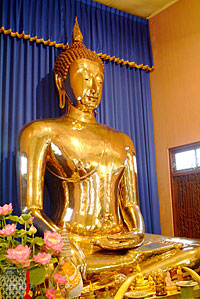THAILAND’S AND THE WORLD’S PRESTIGIOUS SCULPTURE
Well-known Worldwide

Phra Buddha Maha Suwan Patimakorn commonly known as the “Golden Buddha Image of Wat Traimit Wittayaram” is the one and only gold Buddha image in Thailand that was recorded in the Guinness Book of World Records in 1991 as the world’s largest gold Buddha image. This has made the name of the revered icon known worldwide. It is regarded as an invaluable part of the cultural heritage related to Buddhism and the Thai nation.
The World’s Most Treasured Object of Worship
Phra Buddha Maha Suwan Patimakorn is a metal sculpture deemed to be a most valuable object of worship for these reasons:
- Size: This gigantic Buddha Image is six elbow length and five inches (Thai measurement system) or over 2.5 metres in the lap span and the height from the base of the statue to the flame-like halo is seven elbow length, one hand span and nine inches or 3.04 metres (10 feet). The weight is 5.5 tons or 5,500 kilograms (equivalent to 110 people who each weigh 50 kilograms).
- Value: The image is made of gold that is worth more than 21 million pounds according to the Guinness Book of World Records of 1990.
- Age: The image was presumed to be cast in the Sukhothai Period or over seven hundred years ago.

Over 700 Years of Age
The Gold Buddha Image, created during the Sukhothai Era, is the oldest and largest figure to be cast in gold. The age of the image can be deduced not only from the cast material but also from the written evidence. Lines 23 -27 of the first stone slab of King Ramkhamhaeng the Great read: “In the middle of Sukhothai City, there are a Vihan, a gold Buddha image, Phra Attharot Buddha images, large Buddha images, medium sized Buddha images, large Vihan buildings, medium sized Vihan buildings”.
The above quotation shows that during the Sukhothai Period, they had Vihan buildings and Buddha images, large and medium size, made of stucco, metal and gold, as seen in the sculptures of the period that still survive today. For this reason, it is assumed that the Gold Buddha image was cast in the reign of King Ramkhamhaeng the Great before the year 1283 when the King created the Thai alphabet. This suggests the statue is now over 700 years of age.
Laboratory Dating of the Plaster and Black Lacquer
In an attempt to detect the age of the Gold Buddha image, the project committee in cooperation with the Concrete Products and Aggregate Company Limited (CPAC), examined the plaster and black lacquer applied to conceal the image during the decline of Sukhothai Kingdom, based on current knowledge in the fields of concrete technology and the science of radioactivity.
In the first stage, the age of the plaster was to be established. Using state-of-the-art technology, an attempt was made to establish the depth at which carbonation – a chemical reaction between calcium hydroxide and carbon dioxide – occurred. However this was not feasible because the plaster coating of the Gold Buddha image was highly porous and less than one inch thick.
Consequently, the project committee requested the Office of Atoms for Peace (OAP) to carry out radioactive analysis of the black lacquer applied to the image. A sample of the black lacquer was sent to specialists on December 15, 2006 and is now being studied in a laboratory.
Characteristics of the Golden Buddha Image – a testimony to Sukhothai craftsmanship

The Gold Buddha Image is in the attitude of subduing the Mara. The image personifies Buddha images employing the Sukhothai art style, which is considered to be the most exquisite and intricate of any period of Thai art as follows:
As the renown of the Gold Buddha Image’s aesthetic beauty has spread worldwide, each day a large number of tourists, local and foreign, comes to pay respect to the image as well as to appreciate this invaluable masterwork of Thai cultural heritage.
Histrory of Phra Buddha Maha Suwannapatimakon

Originally, the Gold Buddha Image was enshrined in Wat Mahathat in the centre of Sukhothai City. When the Sukhothai kingdom started to decline owing to the expansion of the neighbouring kingdoms, its people applied black lacquer and plaster to the Gold Buddha image to conceal it from plunderers.
In the reign of King BuddhaYod Fa Chulalok the Great (Rama I) in the Rattanakosin Period, his Majesty had the important Buddha images in the provinces transferred to be housed in temples in Bangkok and this included the Gold Buddha Image which was then covered with plaster. Initially, the Image was enshrined in Wat Phraya Krai and in 1935 was transferred to Wat Traimit Wittayaram, which was then commonly known by the name Wat Samchin.
The public realized that there was gold underneath the plaster in 1955 when the Gold Buddha Image was being moved to be housed in the Vihan building. The ropes that were being used to lift the image from the ground broke, causing the image to fall heavily to the ground and the plaster coating chipped. The plaster and lacquer were subsequently removed to reveal a large Buddha statue made of solid gold. A key was found in its base and thus could be used to disassemble the image into nine parts to facilitate its transportation.
The size and weight of the Gold Buddha Image reflect the artistic ability of the craftsmen both in their design and in casting. That the image can be separated into parts makes it easy to transport. People in the olden days were so conscientious in their attempts to protect the Buddha image from harm that it has become an invaluable piece of heritage and has been handed down to the Thai people of today.
Important Incidents
It was assumed that the Gold Buddha Image was cast in the reign of King Ramkhamhaeng the Great in the Sukhothai Period, prior to 1283.
- Later in 1801, King Rama I had the important Buddha images in the provinces transferred to be housed in Wat Pho in the Tha Tian area. The Gold Buddha Image, which was then covered with plaster, was moved from the North to be enshrined in Wat Phraya Krai, whose name was changed to Wat Chotanaram in the reign of King Nang Klao (Rama III). The temple was in the current Yan Nawa District and is now the location of the East Asiatic (Thailand) Public Company Limited.
- In 1935, Phra Maha Chiam Kamalo had the Buddha image moved from Wat Chotanaram to Wat Samchin in a large truck. The telephone and electric tram lines along the way to Wat Samchin had to be propped up with long poles in an attempt to let the image pass under without being entangled with them.
- In 1955, Wat Traimit Wittayaram had the plaster-covered Buddha Image enshrined in the new Vihan building.
- In 1991, the Buddha Image was recorded in the Guinness Book of World Records as the largest gold Buddha Image in the world.
- In 1992, His Majesty King Bhumibol Adulyadej named the Buddha Image, “Phra Buddha Maha Suwan Patimakorn”.
- In 2006, the Project on the Construction of Phra Maha Mondop to enshrine the Gold Buddha Image was launched. The project aims to commemorate the 2006 sixtieth anniversary of His Majesty’s Accession to the Throne and the eightieth royal birthday celebration in 2007.
Credit=http://www.goldenbuddha-thailand.com
Leave a Comment so far
Leave a comment